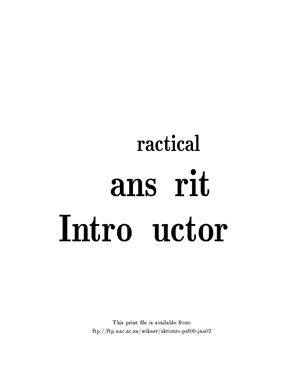Год: 1996
Количество страниц: 156
Язык: Английский
This course of fifteen lessons is intended to lift the English-speaking student who knows nothing of Sanskrit, to the level where he can intelligently apply Monier-Williams' dictionary and the Dhatu-Patha to the study of the scriptures.
The first five lessons cover the pronunciation of the basic Sanskrit alphabet, together with its written form in both DevanagarT and transliterated Roman: flash cards are included as an aid. The notes on pronunciation are largely descriptive, based on mouth position and effort, with similar English (Received Pronunciation) sounds offered where possible. The next four lessons describe vowel embellishments to the consonants, the principles of conjunct consonants, and additions to and variations in the DevanagarT alphabet. Lessons ten and eleven present sandhi in grid form and explain their principles in sound. The next three lessons penetrate Monier-Williams' dictionary through its four levels of alphabetical order, and suggest strategies for finding difficult words. The last lesson shows the extraction of the artha from the Dhatu-Patha, and the application of this and the dictionary to the study of the scriptures.
In addition to the primary course, the first eleven lessons include a 'B' section which introduces the student to the principles of sentence structure in this fully inflected language. Six declension paradigms and class-1 conjugation in the present tense are used with a minimal vocabulary of nineteen words. In the 'B' part of lessons ten and eleven the principles of compound words are introduced.
The course aims at a practical understanding of the basic principles, at getting a 'feel' for the language, and not a leaing of rules by rote. To this end, each lesson concludes with exercises for the student to put that understanding into practice: answers to the exercises are presented in an appendix.
Количество страниц: 156
Язык: Английский
This course of fifteen lessons is intended to lift the English-speaking student who knows nothing of Sanskrit, to the level where he can intelligently apply Monier-Williams' dictionary and the Dhatu-Patha to the study of the scriptures.
The first five lessons cover the pronunciation of the basic Sanskrit alphabet, together with its written form in both DevanagarT and transliterated Roman: flash cards are included as an aid. The notes on pronunciation are largely descriptive, based on mouth position and effort, with similar English (Received Pronunciation) sounds offered where possible. The next four lessons describe vowel embellishments to the consonants, the principles of conjunct consonants, and additions to and variations in the DevanagarT alphabet. Lessons ten and eleven present sandhi in grid form and explain their principles in sound. The next three lessons penetrate Monier-Williams' dictionary through its four levels of alphabetical order, and suggest strategies for finding difficult words. The last lesson shows the extraction of the artha from the Dhatu-Patha, and the application of this and the dictionary to the study of the scriptures.
In addition to the primary course, the first eleven lessons include a 'B' section which introduces the student to the principles of sentence structure in this fully inflected language. Six declension paradigms and class-1 conjugation in the present tense are used with a minimal vocabulary of nineteen words. In the 'B' part of lessons ten and eleven the principles of compound words are introduced.
The course aims at a practical understanding of the basic principles, at getting a 'feel' for the language, and not a leaing of rules by rote. To this end, each lesson concludes with exercises for the student to put that understanding into practice: answers to the exercises are presented in an appendix.

